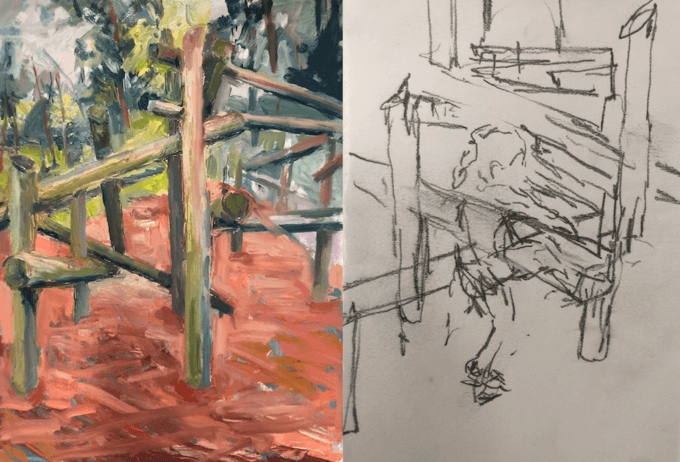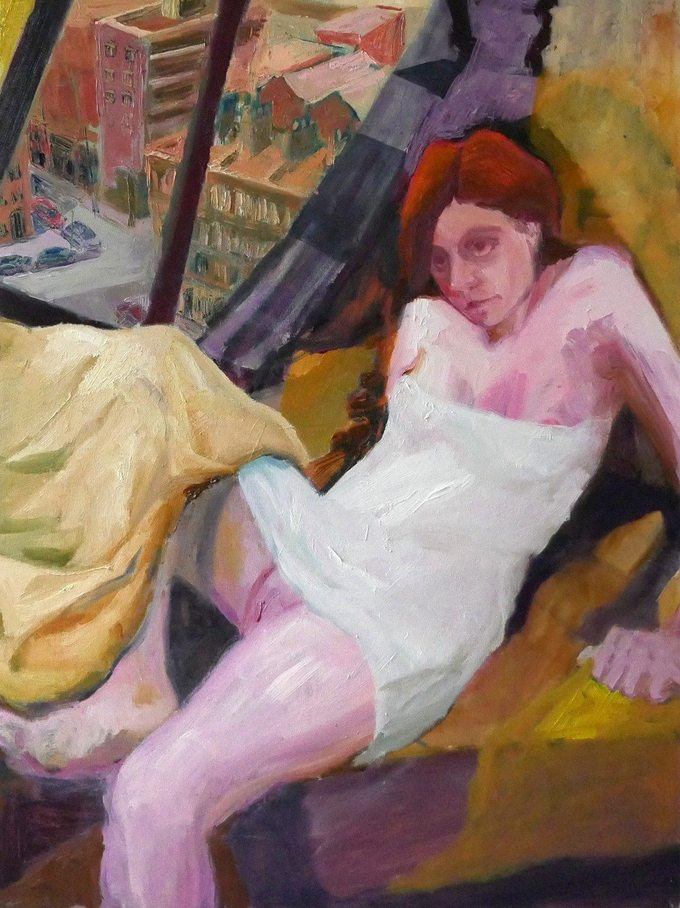Rachel Mercer has recently joined Rise Art. Rachel paints to capture the movement and actions of people in their dealings with space and each other, examining physical and emotional connections through dynamic portraits and contorted compositions.

Rachel drawing outdoor near a playground.
How would you describe your style and the work you create?
I paint figures in dynamic and sometimes contorted positions, they appear captured in motion, moving through the space. The figures meet the world and each other and express physical and emotional connections. The paintings are in oil and mostly from imagination or memory. I generate the imagery by drawing the places I have been, people I’ve seen including people I know well.
My paintings are characterised by the visible brushstrokes and layering; scrapped and wiped surfaces sometimes thin, with moments of impasto. I want every mark in the painting to represent how I perceive things. I have a particular interest in the texture of skin and clothing, and this is reflected in the surface quality of my artworks. Fragmented brushstrokes express the complexities of binocular vision and the distortion of space accounts for being able to see 180 degrees in our peripheral vision.

Vanish, 2021, oil on Board, 83 x 64cm
Tell us a bit about the inspiration behind your practice
It is interactions between humans that I find most inspiring. Because my imagery is about lived experience and first-person observations, the main way I find inspiration is through observational drawing.

Climbing frame study, 2022, oil paint on paper, 90 x 76cm and a quick sketch of a child climbing
How do you go about choosing the subjects and scenes for your paintings?
My drawings help me select a subject. Drawing whatever catches my eye sometimes reveals things I didn’t know about my interests. I also like to think that when I’m drawing, I’m visually absorbing and adding images to my mental database, so that when I’m back in the studio the drawings take me back to the remembered experience. Sometimes I paint directly from the drawings but sometimes, the memory of drawing is enough. I don’t use photographs because, for me, they distract from more experiential and tactile memories. When I first start a painting it’s more like a drawing in colour, if this fails to satisfy or feel true to me then I will paint over the top. Overlaying images brings in an element of chance, sometimes the image reveals itself.

Amputation, 2022, oil on Board, 17 x 23cm
How has your practice evolved in recent years?
In the last year I have moved away more narrative forms of figuration. My practice now aims to embrace chance and openness. Chance methods produce opportunities for a greater sense of movement and rhythmic fluency within the painting. The loose brushwork means the figures appear somewhere between presence and disappearance. I now find the process of painting incredibly freeing; I am enjoying the increased connection between impulse and painterly mark.

Alone Again, 2021, oil on canvas, 90 x 70cm
What’s an average day like in your studio?
A cycle ride to the studio means I’m mentally and physically raring to go. I will begin with studio admin: priming, stretching or preparing surfaces. I may then work on a painting started the evening before, I find its good for consistency if I pick-up where I left-off. If things go well, I might be painting the whole day, however if things are feeling sticky I might do some drawing. If a drawing has potential, it’s an occasion celebrated with the start of a new painting.

Rachel’s temporary studio space and some works in progress at Dumfries House
What/Who are your key influences?
I am particularly fond of Rembrandt’s ‘A Woman Bathing In A Stream’ (National Gallery) and his ‘Self-portrait with Two Circles’ (Kenwood House). From the age of 13 I was in I love with Rembrandt’s use of paint and texture that makes skin and fabric look alive. Gwen John’s ‘The Convalescent’ (at the Fitzwilliam Museum) was also a huge influence on me as a student. I was also very influenced by Chinese ink painting from the Song Dynasty. Studying at the Royal Drawing School lead me to artists like Leon Kossoff, Chaïm Soutine and R.B. Kitaj who helped me see how my practice and tuition in Chinese brush painting could be applied to figurative representation in oil paint.

Great Wall, 2019, oil on board, 102 x 76cm
Who are some Rise Art artists with work you’re enjoying at the moment?
I’ve followed Robbie Bushe’s work for a while on Instagram, I love his scenes of imagined, futuristic cities, he’s one to buy sooner rather than later! Through Rise Art I discovered the work of Kate McCrickard, her paintings are emotional and tender but also powerful with some gutsy painting, I really look forward to seeing the work she posts next.

Catastrophise, 2022, oil on canvas, 42 x 60cm
Are you currently working on any exciting new projects?
I recently returned from a residency at Dumfries House, Scotland organised by the Royal Drawing School. This two-week residency was a chance for sustained, uninterrupted painting. It was excellent because I was able to move seamlessly between outdoor painting and studio work. I am currently working on a body of paintings on the theme of children in playgrounds. The artist’s studio at Dumfries house is right next to a children’s park, around lunchtime when the playground was busiest, I made drawings of the children playing. If the playground was empty, I made studies of the playground architecture: slides, climbing frames and see-saws.



:strip_icc()/BHG_PTSN19720-33d9cd22f6ab49e6a21982e451321898.jpg)

More Stories
BSA Film Friday: 11.25.22 | Brooklyn Street Art
FEATURES – Art in VR with Casey Koyczan
Julie Karpodini: Painting Instinct – Jackson’s Art Blog